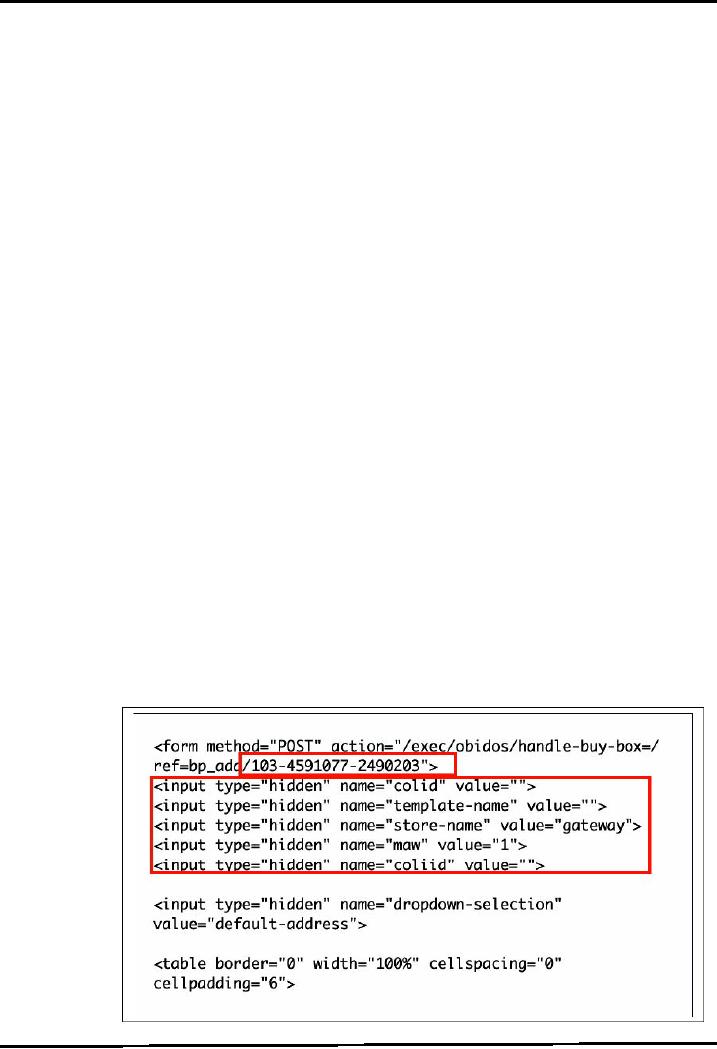 |
JAVA: Session Tracking 2 |
| << JAVA: Session Tracking 1 |
| JAVA: AddressBook Case Study Using Sevlets >> |

Web
Design & Development CS506
VU
Lesson
32
Session
Tracking 2
In the last
handout we have discussed the solutions
for session tracking and
talked about one
important
mechanism
cookies in detail. We said cookies allow
the server to store information on a
client machine and
later
retrieve it. Now we will
see two more mechanisms that
provide us facility to maintain a
session
between user's
requests. These are URL
Rewriting and Hidden Form
Fields. After that we will
discuss a
session
tracking API provided by
java.
URL
Rewriting
URL
rewriting provides another way
for session tracking. With
URL rewriting, the parameter
that we want
to
pass back and forth between the server
and client is appended to the URL.
This appended
information
can
be retrieve by parsing the URL. This
information can be in the form
of:
.
Extra
path information,
.
Added
parameters, or
.
Some
custom, server-specific URL
change
Note:
Due
to limited space available in
rewriting a URL, the extra
information is usually limited to
a
unique
session ID.
The
following URLs have been
rewritten to pass the session ID
123
.
Original
http://server:
port/servlet /rewrite
.
Extra path information
http://server:
port/servlet/rewrite/123
.
Added parameters
http://server:
port/servlet/rewrite?id=123
.
Custom change
http://server:
port/servlet/rewrite;$id$123
Disadvantages
of URL rewriting
The
following Disadvantages of URL rewriting,
are considerable: -
What
if the user bookmarks the page and the
problem get worse if server is
not assigning a unique
session
id.
Every
URL on a page, which needs
the session information, must be
rewritten each time page
is
served,
which can cause
o Computationally
expensive
o Can
increase communication overhead
Unlike
cookies, state information stored in the
URL is not persistent
This
mechanism limits the client
interaction with the server to
HTTP GET request.
Example
Code: OnlineBookStore using URL
Rewriting
This
is the modified version of online
book store (selling two
books only, however you
can add in on your
own)
that is built using cookies in the last
handout. Another important
difference is books are
displayed in
the
form of hyperlink instead of check boxes.
URL rewriting mechanism is
used to maintain
session
information.
How to
make Query String
Before
jumping on to example, one important
technique is needed to be learned
i.e. making on query
string.
If
you ever noticed the URL of
a servlet in a browser that is receiving
some HTML form values,
also
contains the HTML
fields name with values
entered/selected by the user.
Now,
if you want to pass some
attribute and values along with
URL, you can use the
technique of query
string.
Attribute names and values are
written in pair form after
the ?. For
example, if you want to
send
attribute
"name" and its value "ali",
the URL will look
like
Original
URL
http://server:port/servletex
/register
After
adding parameters
http://server:port/servletex/register
?name=ali
235

Web
Design & Development CS506
VU
If
you want to add more than one
parameter, all subsequent
parameters are separated by
&
sign.
For
example
Adding
two parameters
http://server:port/servletex/register
?name=ali&address=gulberg
URLRewriteServlet.java
import
java.io.*;import java.net.*;import
javax.servlet.*;import
javax.servlet.http.*;
public
class URLRewriteServlet
extends
HttpServlet {
//
used to generate a unique
value which is
//
used as a cookie
value
public
static int S_ID = 1;
//
used to store HashMaps of
indiviual users
public
static HashMap globalMap = new
HashMap();
//
Handles the HTTP GET
method.
protected
void doGet(HttpServletRequest
request,
HttpServletResponse
response)throws ServletException,
IOException{
processRequest(request,
response);
}
//
Handles the HTTP <code>POST</code>
method.
protected
void doPost(HttpServletRequest
request,
HttpServletResponse
response)throws ServletException,
IOException{
processRequest(request,
response);
}
//
called from both doGet()
& doPost()protected void
processRequest(HttpServletRequest
request,HttpServletResponse
response)throws
ServletException, IOException {
//
declaring user's
HashMap
HashMap
sessionInfo = null;
//
reading sessionId
String
sID =
request.getParameter("JSESSIONID");
/* if
parameter JSESSIONID is received,
means that user isvisiting
the site for the first
time.
*/
if (sID
== null)
{
// make a
unique string
sID =
makeUniqueString();
//
creating a HashMap where books selected
by the
//
user will be stored
sessionInfo
= new HashMap();
// add the
user's HashMap (sessionInfo)
into the
//
globalMap against unique string
i.e. sID
globalMap.put(sID,
sessionInfo);
}else
{
// if
parameter "JSESSIONID" has
some value
//
retrieve a HashMap from the
globalMap against
236

Web
Design & Development CS506
VU
//
sID i.e. unique string
which is your sessionID
sessionInfo
= (HashMap)globalMap.get(sID);
}
response.setContentType("text/html;charset=UTF-8");
PrintWriter
out = response.getWriter();
out.println("<html>");
out.println("<head>");
out.println("<title>Shopping
Cart Example</title>");
out.println("</head>");
out.println("<body>");
out.println("<h1>Online
Book Store</h1>");
//
Making three URLS by using
query string mechanism// The
attributes/parameters are JSSESSIONID
and
book
name (like// firstCB) along
with values sID and book
name respectively
String
firsturl
="http://localhost:8084/urlbookstore/urlrewriteservlet?JSESSIONID="
+ sID
+ "&firstCB=firstCB";
String
secondurl
="http://localhost:8084/urlbookstore/urlrewriteservlet?JSESSIONID="
+ sID
+ "&secondCB=secondCB";
out.println("<h3><a
href=" + firsturl
+
">" + " java core servlts
</a> </h3>"
+"<br>"+
"<h3><a
href=" + secondurl
+
">" +
"
java how to program
</a> </h3>" +
"<br>"+
);
out.println("<br/>");
out.println("<h1>You
have selected following
books</h1>");
out.println("<br/>");
//retrieving
params that are emebded in
URLs
String
fBook = request.getParameter("firstCB");String sBook
=
request.getParameter("secondCB");
// if
first book is selected then
add it to
//
user's HashMap i.e.
sessionInfo
if (
fBook != null &&
fBook.equals("firstCB") ) {
sessionInfo.put("firstCB",
"java core
servlets");
}
// if
second book is selected then
add it to
//
user's HashMap i.e.
sessionInfo
if
(sBook != null &&
sBook.equals("secondCB")){
sessionInfo.put("secondCB",
"java how to
program");
}
//
used to display the books currently
stored in
// the
user's HashMap i.e.
sessionInfo
237

Web
Design & Development CS506
VU
printSessionInfo(out,
sessionInfo);
out.println("</body>");
out.println("</html>");
out.close();
} //
end processRequest()
// method
used to generate a unique
string
public
String makeUniqueString(){return "ABC"
+
S_ID++;}
// returns a
reference global HashMap.
public
static HashMap
findTableStoringSessions(){return
globalMap;}
//
used to print the books currently
stored in// user's HashMap.
i.e. sessionInfo
public
void printSessionInfo(PrintWriter
out,HashMap sessionInfo){ String
title = "";
title=
(String)sessionInfo.get("firstCB");
if
(title != null){
out.println("<h3>
"+ title +"</h3>");
}
title=
(String)sessionInfo.get("secondCB");
if
(title != null){
out.println("<h3>
"+ title +"</h3>");
}
} // end
URLRewriteServlet
web.xml
<?xml
version="1.0"
encoding="UTF-8"?>
<web-app>
<servlet>
<servlet-name> URLRewriteServlet
</servlet-name><servlet-class>
URLRewriteServlet
</servlet-class>
</servlet>
<servlet-mapping><servlet-name>
URLRewriteServlet
</servlet-name><url-pattern>
/urlrewriteservlet
</url-pattern>
</servlet-mapping>
</web-app>
Hidden
Form
Fields
HTML
forms
can
have an
element
that
looks
like the
following:
<INPUT
TYPE="HIDDEN"
NAME="sessionid" VALUE="123" />
238

Web
Design & Development CS506
VU
Hidden
Forms Fields do not affect
the appearance of HTML page. They
actually contain the
information
that
is needed to send to the server. Thus,
hidden fields can also be
used to store information
(like
sessionid)
in order to maintain
session.
In the above
figure you can see the
use of Hidden form fields
for storing particular
information.
Java Solution
for Session
Tracking
Java
provides an excellent solution to
all the problems that occurred in
tracking a session. The
Servlet API
provides
several methods and classes
specifically designed to handle session
tracking. In other words,
servlets have
built in session
tracking.
Sessions
are represented by an HttpSession object.
HttpSession tacking API built on top of
URL rewriting
and cookies. All
cookies and URL rewriting mechanism is
hidden and most application
server uses cookies
but
automatically revert to URL
rewriting when cookies are unsupported or
explicitly disabled.
Using
HttpSessionAPI
in servlets is straightforward and involves
looking up the session object
associated with the
current
request, creating new
session object when
necessary, looking up information
associated with a
session,
storing information in a session, and
discarding completed or abandoned
sessions.
Working
with HttpSession
Let's
have a look on HttpSession working step
by step.
1. Getting
the user's session
object
To get the
user's session object, we
call the getSession() method of
HttpServeltRequestthat returns the
object
of HttpSession
HttpSession
sess = request.getSession(true);
If
true is passed to the getSession()
method, this method returns the current
session associated with
this
request,
or, if the request does not
have a session, it creates a new one. We
can confirm whether
this
session
object (sess) is newly
created or returned by using
isNew() method of HttpSession. In case
of
passing
false, null is returned if the session
doesn't exist.
2. Storing
information in a Session
To
store information in Session
object (sess), we use
setAttribute() method of HttpSession
class.
Session
object works like a HashMap,
so it is able to store any
java object against key. So
you can store
number of
keys and their values in pair
form. For example,
sess.setAttribute("sessionid",
"123");
3.
Looking up information associated
with a Session
To
retrieve back the stored information
from session object,
getAttribute()method of HttpSession
class
is
used. For example,
String
sid=(String)sess.getAttribute("sessionid");
Note:
-getAttribute()
method returns Object type, so typecast
is required.
4.
Terminating a Session
After
the amount of time, session
gets terminated automatically. We
can see its maximum
activation
time
by using getMaxInactiveInterval() method of
HttpSession class. However, we can
also terminate
any
existing session manually.
For this, we need to call
invalidate() method of HttpSessionclass
as
shown
below.
sess.invalidate()
Example
Code: Showing Session
Information
To understand
HttpSession API properly we need to have a
look on an example. In this
example, we will
get the
session object and check
whether it is a new user or
not. If the user is visiting
for the first time,
we
will
print "Welcome" and if we find the
old one, we'll print
"Welcome Back". Moreover, we
will print the
session
information and count the number of
accesses for every
user
import
java.io.*;
239

Web
Design & Development CS506
VU
import
java.net.*;
import
javax.servlet.*;
import
javax.servlet.http.*;
public
class ShowSessionServlet
extends
HttpServlet {
//
Handles the HTTP
<code>GET</code> method.
protected
void doGet(HttpServletRequest
request, HttpServletResponse
response)
throws
ServletException, IOException
{
processRequest(request,
response);
}
//
Handles the HTTP <code>POST</code>
method.
protected
void doPost(HttpServletRequest
request, HttpServletResponse
response)
throws
ServletException, IOException
{
processRequest(request,
response);
}
//
called from both doGet()
& doPost()
protected
void processRequest(HttpServletRequest
request, HttpServletResponse
response)
throws
ServletException, IOException
{
//
used for displaying message
(like Welcomem, Newcomer) to
user
private
String heading;
response.setContentType("text/html");
//
Getting session
object
HttpSession
session =
request.getSession(true);
/*
Getting stored information
using getAttribute() method
*/
Integer
accessCount =
(Integer)session.getAttribute("sessionCount");
/* If
user comes for the first
time, accessCount
will
be
assigned
null, so we
can guess easily that
this a new user */
if
(accessCount == null)
{
accessCount
= new Integer(1);
heading
= "Welcome, Newcomer";
}
else
{
heading
= "Welcome Back";
//
Incrementing the value
accessCount
= new Integer(accessCount.intValue() +
1);
}
/*
Storing the new value of
accessCount in the session
using
setAttribute()
method */
session.setAttribute("sessionCount",
accessCount);
//
Getting the PrintWriter
PrintWriter
out = response.getWriter();
/*Generating
HTML tags using PrintWriter to
print session info
and
no of times this user has
accessed this page */
out.println("<HTML>"
+ " <BODY>" + " <h1>Session
Tracking Example</h1>" +
"
<H2>Information on Your
Session:</H2>\n" +
240

Web
Design & Development CS506
VU
"
<H3> Session ID: " +
session.getId() + "</H3>"
+
"
<H3>Number of Previous Accesses: "
+ accessCount +
"
</H3>" +
"
</BODY>" +
"
</HTML>"
);
//Closing
the PrintWriter stream
out.close();
} //
end processRequest
} //
end ShowSessionServlet class
web.xml
<?xml
version="1.0"
encoding="UTF-8"?>
<web-app>
<servlet>
<servlet-name> ShowSession
</servlet-name><servlet-class>
ShowSessionServlet
</servlet-
class>
</servlet>
<servlet-mapping>
<servlet-name>
ShowSession
</servlet-name>
<url-pattern>
/showsession
</url-pattern>
</servlet-mapping>
</web-app>
HttpSession
Behind the
scenes
When
we call getSession() method, there is a
lot going on behind the
scenes. For every user, a
unique
session
ID is assigned automatically. As the
server deals with lot of
users at a time, this ID is
used to
distinguish
one user from another. Now
here is the question, how
this ID sends to the user?
Answer is,
there
are two options
Option
1: If the browser
supports cookies, the Servlet will
automatically creates a session
cookie
and
store the session ID within
that cookie.
Option
2: If the
first option fails because
of browser that does not support cookies
then the Servlet
will
try to extract the session ID
from the URL
Encoding
URLs sent to
Client
Servlet
will automatically switch to
URL rewriting when cookies
are not supported or disabled by
the
client.
When Session Tracking is
based on URL rewriting, it requires
additional help from the Servlets.
For
a
Servlet to support session tracking
via URL rewriting, it has to
rewrite (encode) every local
URL before
sending it to the
client. Now see how
this encoding works
HttpServletResponse
provides two methods to
perform encoding
String
encodeURL(String URL)
String
encodeRedirectURL(String URL)
If
Cookies are disabled, both
methods encode (rewrite) the
specific URL to include the
session ID and
returns the
new URL. However, if cookies
are enabled, the URL is returned
unchanged.
241

Web
Design & Development CS506
VU
Difference
between encodeURL() and
encodeRedirectURL()
encodeURL()
is used for URLs that
are embedded in the webpage, that the
servlet generates. For
example,
String
URL = "/servlet/sessiontracker";
String
eURL = response.encodeURL(URL);
out.println("<A
HREF=\" " + eURL + "\ "> ......
</A>");
Whereas
encodeRedirectURL() is used for
URLs that refers yours site is in
sendRedirect() call. For
example,
String
URL = "/servlet/sessiontracker";
String
eURL =
response.encodeRedirectURL(URL);
Response.sendRedirect(eURL);
Example
Code: OnlineBookStore using
HttpSession
This
book store is modified
version of last one, which is built
using URL rewriting
mechanism. Here,
HttpSession
will be used to maintain
session.
ShoppingCartServlet.java
import
java.io.*;import java.net.*;import
javax.servlet.*;import
javax.servlet.http.*;
public
class ShoppingCartServlet
extends
HttpServlet {
//
Handles the HTTP GET
method.
protected
void doGet(HttpServletRequest
request,
HttpServletResponse
response)throws ServletException,
IOException{
processRequest(request,
response);
}
//
Handles the HTTP <code>POST</code>
method.
protected
void doPost(HttpServletRequest
request,
HttpServletResponse
response)throws ServletException,
IOException{
processRequest(request,
response);
}
//
called from both doGet()
& doPost()protected void
processRequest(HttpServletRequest
request,HttpServletResponse response)throws
ServletException,
IOException {
response.setContentType("text/html;charset=UTF-8");
HttpSession
session = request.getSession(true);
PrintWriter
out = response.getWriter();
out.println("<html>");
out.println("<head>");
out.println("<title>Shopping
Cart Example</title>");
out.println("</head>");
out.println("<body>");
out.println("<h1>Online
Book Store</h1>");
//
First URL built using
query string, representing first
book
String
firstURL
="http://localhost:8084/urlrewritebookstore/shoppingcart?book=first"
242

Web
Design & Development CS506
VU
//
Second URL built using
query string, representing second
book// Note that parameter
name is still book,
so
that later we need // to
read only this
parameter
String
secondURL
="http://localhost:8084/urlrewritebookstore/shoppingcart?book=second"
//
Encoding URLs
String
eURL1 = response.encodeURL( firstURL
);String eURL2 =
response.encodeURL(
secondURL );
out.println("<h3><a
href=" + eURL1
+
">" + " java core servlets
</a> </h3>"
+"<br>"+
"<h3><a
href=" + eURL2
+
">" +
"
java How to Program </a>
</h3>"
);
out.println("<br/>");
out.println("<h1>You
have selected following
books</h1>");
out.println("<br/>");
//retrieving
params that are emebded in
URLs
String
fBook = request.getParameter("firstCB");String sBook
=
request.getParameter("secondCB");
out.println("<br/>");
out.println("<h1>You
have selected following
books</h1>");
out.println("<br/>");
//retrieving
param that is embedded into
URL
String
book = request.getParameter("book");
if (book !=
null){
// if
firstURL, value of first
hyperlink is clicked// then
storing the book into
session object against
fBook
if
(book.equals("first")){session.setAttribute("fBook",
"java core
servlets");}
// if
secondURL, value of second
hyperlink is clicked// then
storing the book into
session object
against
sBook
else
if(book.equals("second")){session.setAttribute("sBook", "java
how
to
program");}
}//outer
if ends
//
used to display the books currently
stored in
// the HttpSession
object i.e. session
printSessionInfo(out,
session);
out.println("</body>");
out.println("</html>");
out.close();
} //
end processRequest()
//
used to display values stored in
HttpSession object
public
void printSessionInfo(PrintWriter
out,HttpSession session){ String title =
"";
//
reading value against key
fBook from session,// if
exist displays it
title=
(String)session.getAttribute("fBook");
if
(title != null){
out.println("<h3>
"+ title +"</h3>");
}
//
reading value against key
sBook from session,// if
exist displays it
title=
(String)session.getAttribute("sBook");
243

Web
Design & Development CS506
VU
if
(title != null){
out.println("<h3>
"+ title +"</h3>");
}
} // end
printSessionInfo
} // end
ShoppingCartServlet
web.xml
<?xml
version="1.0"
encoding="UTF-8"?>
<web-app>
<servlet>
<servlet-name> ShoppingCartServlet
</servlet-name>
<servlet-class>
ShoppingCartServlet
</servlet-class>
</servlet>
<servlet-mapping><servlet-name>
ShoppingCartServlet
</servlet-name>
<url-pattern>
/shoppingcart
</url-pattern>
</servlet-mapping>
</web-app>
Some
Methods of HttpSession
Now
let's explore some methods
of HttpSessionclass
. setAttribute(String,
Object)
This
method associates a value with a
name.
. getAttribute(String)
Extracts
previously stored value from
a session object. It returns nullif no
value is associated
with
the
given name
. removeAttribute(String)
This
method removes values associated with the
name
. getId(
)
This
method returns the unique identifier of
this session
. getCreationTime(
)
This
method returns time at which session
was first created
. getMaxInactiveInterval(
) , setMaxInactiveInterval(int)
To get or
set the amount of time session
should go without access
before being
invalidated.
References:
Java
A Lab Course by Umair
Javed
Core Servlets
and JSP by Marty
Hall
Stanford
Course Internet
Technologies
Java
Tutorial on Servlets
http://java.sun.com/j2ee/tutorial/1_3-fcs/doc/Servlets11.html
Java
API documentation
244
Table of Contents:
- JAVA FEATURES
- Java Virtual Machine & Runtime Environment
- Learning Basics of JAVA
- JAVA: Object Oriented Programming
- JAVA: Inheritance
- JAVA: Collections
- JAVA: Intro to Exceptions
- JAVA: Streams
- JAVA: Modification of Address Book Code
- JAVA: Graphical User Interfaces
- JAVA: Event Handling
- JAVA: More Examples of Handling Events
- JAVA: Problem in Last Code Example
- Java Database Connectivity
- JAVA: More on JDBC
- JAVA: Result Set
- JAVA: Meta Data
- Java Graphics
- JAVA: How to Animate
- JAVA Applets
- JAVA: Socket Programming
- JAVA: Serialization
- JAVA: Multithreading 1
- JAVA: Multithreading 2
- JAVA Web Application Development
- Java Servlets
- JAVA: Creating a Simple Web Application in Tomcat
- JAVA: Servlets Lifecycle
- JAVA: More on Servlets
- JAVA: Dispatching Requests
- JAVA: Session Tracking 1
- JAVA: Session Tracking 2
- JAVA: AddressBook Case Study Using Sevlets
- Java Server Pages 1
- JavaServer Pages 2
- Java Server Pages 3
- JAVA: JSP Action Elements and Scope
- JAVA: JSP Custom Tags
- JAVA: MVC + Case Study
- JAVA: MVC Model 2 Architecture
- JAVA: Layers and Tiers
- JAVA: Expression Language
- JAVA: JavaServer Pages Standard Tag Library (JSTL)
- JAVA: Client Side Validation & JavaServer Faces (JSF)
- JAVA: JavaServer Faces